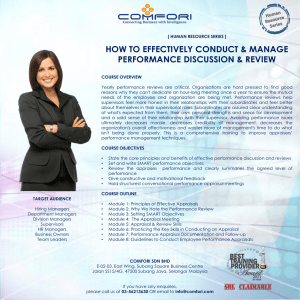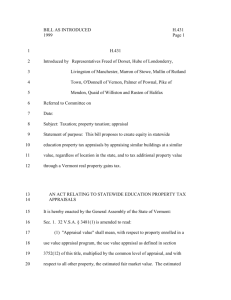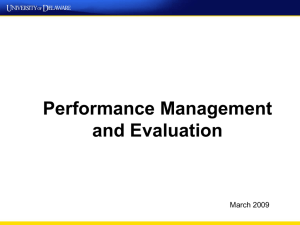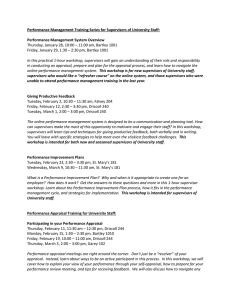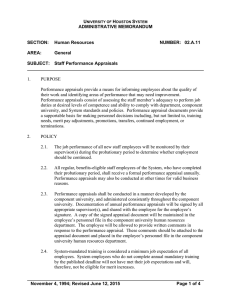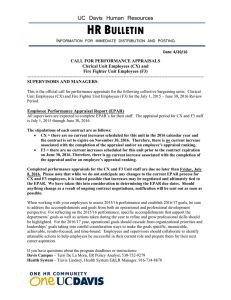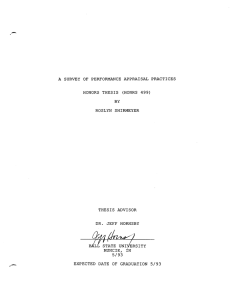Performance Appraisals: Evaluation & Goal-Setting Review Year Timeline 4/1/2009 – 3/31/2010
advertisement
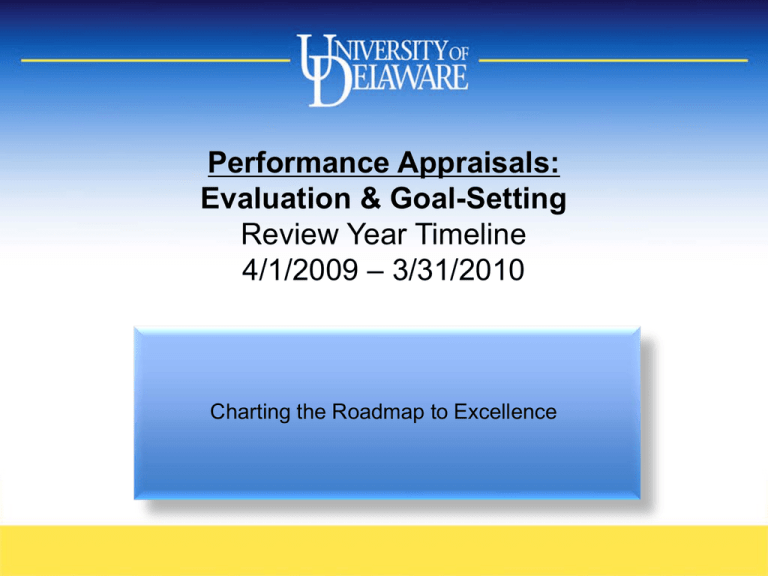
Performance Appraisals: Evaluation & Goal-Setting Review Year Timeline 4/1/2009 – 3/31/2010 Charting the Roadmap to Excellence Agenda • • • • • • • Set the Stage Goal Setting and Goal Alignment Goal Setting Components S.M.A.R.T. Goals Tips for Interactive Goal Setting Supporting Goal Achievement Regular Follow-up Agenda (cont’d) • Revitalize UD’s Performance Appraisal Process • New Electronic Performance Appraisal Form – Employee Portion – Supervisor Portion – Employee Sign-off – HR Review • Question and Answer 2 Set the stage • Preparation – provide advance notice and plan ahead what to say and how to say it. Don't attempt to conduct this session "off the cuff". • Privacy and Confidentiality - Conduct the meeting in a non-public area where both parties will feel more comfortable and willing to be objective and open. • Freedom from Interruption - Hold all telephone calls and inform people in your area that you do not want to be disturbed. You must convey the message that this is an important event. 3 Set the Stage, (cont’d) • Ample Time - Avoid rushing the employee in and out. Allocate an appropriate period of time for each meeting. • Two-Way Communication - Both parties should talk and listen. • When the review process is completed, the employee should: • Clearly understand where he/she stands in terms of meeting performance standards and goals for the next review cycle • Know where and how to improve • Be committed to and motivated to maintaining and/or improving the performance level for the future 4 Action Verbs 5 Job Duties Identify, categorize, weigh and collate data of insects collected this past summer (60%) College or Department name here 6 Job Duties • Conduct experiments on the chemical ecology of insects. • Ensure that a safe and proper working environment is being maintained in the laboratory and field. • Collaborate with undergraduate student employees conducting experiments in the laboratory and field. • Ensure that data are being collected, maintained and reported in an accurate and proper manner. • Assist with analyzing and interpretation of data. • Prepare written progress reports. 7 In the Workplace, Goal-setting is a Valuable Tool That… • Communicates work expectations • Enhances productivity • Encourages on-going communication and collaboration between employees and supervisors • Stimulates long-term vision/planning and short-term motivation • Adds credibility and objectivity to performance evaluations • Helps to align employee and unit goals with strategic employer objectives 8 Goal Alignment at the University UD Strategic Plan College/Division Goals Unit/Department Goals Employee Goals 9 Goal-setting Components • Goal: statement of results to be achieved within a specific timeframe • Standard: ongoing performance criteria to be repeatedly met or exceeded • Competency: employee attribute(s), ability or skill an individual demonstrates at work • Stretch Goal: extremely ambitious goal that prompts “outside-the-box” thinking 10 Create S.M.A.R.T.* Goals • Specific – precise and detailed • Measurable – with criteria for determining progress and success • Achievable – attainable and action-oriented • Realistic – relevant and aligned • Time-related – grounded within a time-frame *Peter Drucker, The Practice of Management 11 Examples of S.M.A.R.T. Goals • Poor Examples: – Reduce customer complaints daily. – Produce budget reports timely. – Provide job quotes to customers. – Produce documents and distribute to departments weekly. – Ensure all projects are completed in a timely manner. 12 Examples of S.M.A.R.T. Goals • Good Examples: – Resolve customer conflicts within 24 hours of the initial interaction to the customer’s satisfaction. – Reconcile the department financial reports by the fifteenth of every month with no increase in reconciliation errors. – Provide job quotes that are no more that 10% off final price. – Produce outgoing documents with zero defects/errors in the final draft. – Ensure that 90% of projects are completed on time and require no rework. 13 Tips for Interactive Goal Setting • Clearly state the performance goal or standard • Break it down into manageable components • Isolate resources needed to accomplish each component • Identify possible barriers • Develop a timeline (e.g., quarterly) to meet and review progress 14 “Need to knows” for supporting goal achievement • • • • • What skills are needed? What information/knowledge is needed? What help/collaboration is needed? What resources are needed? What might block progress? 15 Regular Follow-Up is Critical! • Supervisors should regularly review goal progress with their employees • Dialogue keeps goals fresh and on track • Milestones can help to sustain motivation • Changing needs, priorities and resources may require goal adjustment, postponement or addition of a new goal 16 How can Supervisors Revitalize UD’s Performance Appraisal Process? • Ensure 100 percent participation • Engage in interactive goal-setting • Establish meetings with employees to discuss progress toward goals (quarterly is recommended) • Strengthen the correlation between employee performance and distribution of merit raises • Identify and reward exceptional performance 17 The UD’s New Web Based Performance Appraisal Process 18 Employee Portion Supervisor Portion Employee Signoff HR Review • Appraisals will be sent to HR for review. • After HR review the forms will be completed and update HR with overall rating • Prior forms will be available year round. • A printable view will be available • DEADLINE TO SUBMIT PERFORMANCE APPRAISAL FORMS TO HR IS: 3/31/2010
